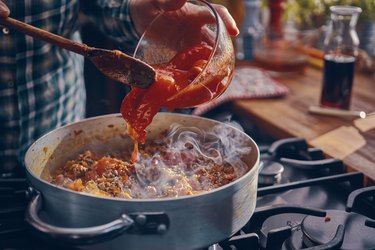
The glycemic index has long been used as a tool for assessing a food's effects on blood sugar levels, but it's not without faults.
We asked registered dietitians and an endocrinologist to explain just how useful the glycemic index (GI) is for people looking to manage their blood sugar — and what to focus on instead.
Video of the Day
Video of the Day
What Is the Glycemic Index?
"Glycemic index is a value used to measure how specific foods increase blood sugar levels," explains Christine Russell, RD, CDCES, a dietitian and certified diabetes care educator and education specialist at the nutrition counseling firm Nourish.
Created by physicians in 1981, the GI seeks to quantify foods' effects on blood glucose levels compared to sugar. Glucose (aka sugar) has a GI of 100. Other foods are then numbered from 0 to 100, with the number quantifying the extent to which a food typically spikes blood sugar levels in comparison to glucose. Here's what that looks like in practice:
- Low-GI foods: Those that tend to cause a slow and steady release of glucose into the bloodstream — they are assigned values from 1 to 55, per the Mayo Clinic.
- Medium-GI foods: These fall in the range of 56 to 69.
- High-GI foods: These often lead to rapid spikes and subsequent crashes in blood sugar levels, and rank 70 and higher.
The GI has long been touted as a helpful tool for those looking to optimize their diet for diabetes management.
"The usefulness of GI is very subjective and nuanced, like most other aspects of nutrition science."
The thinking goes that "high-glycemic index foods would be less optimal for people living with diabetes because these foods are more likely to cause blood sugar spikes and dips, which is not only unfavorable from the standpoint that it can make the person feel unwell but also makes it difficult to figure out proper dosing of medications and insulin regimens," says Maryann Walsh, RD, CDE, dietitian, certified diabetes educator and founder of the practice Walsh Nutrition.
On the flip side, "low-GI foods would be better because they are less likely to cause spikes and dips in blood sugar," Walsh says.
Why the Glycemic Index Isn’t Always Useful
Understanding how certain foods affect blood sugar levels is certainly helpful, whether you've been diagnosed with diabetes or not. But the GI doesn't account for some key factors in this equation.
Here are four reasons the GI isn't the most useful tool when it comes to choosing blood sugar-friendly foods.
1. It Doesn’t Account for Portion Sizes
First things first: "The glycemic index doesn't take into account how much we're actually consuming in one sitting," Russell says.
That is, glycemic index values were assigned to foods based on a serving of that food that contained 50 grams of carbohydrates. For some foods, this serving size makes sense. For example, you'd need to eat about 1 cup of cooked white rice (which has a GI of about 73) to hit 50 grams of carbs from that food. That's a totally realistic portion of rice.
However, you'd need to eat about 7 whole cups of watermelon (which has a GI of about 76) to hit 50 grams of carbs from the fruit. Most people don't eat that much watermelon in one sitting, so the fruit's high GI may not be all that meaningful.
"Portion sizes provide a more accurate picture of how a specific food impacts blood sugar during a meal," Russell says. That's why "glycemic load" was created. Unlike the GI, the glycemic load accounts for both the glycemic index and the actual portion of food eaten.
Take that watermelon, for example. It falls high on the glycemic index, but low in terms of its glycemic load (which is just 8) once a standard serving size is considered, per Oregon State University.
2. The Glycemic Index of Foods Is Subject to Change
A number of variables can modify a food's glycemic index.
"Certain modes of preparation or even natural processes such as the ripening of fruit can change the GI of a food," Walsh explains. "For example, the riper the banana gets the higher its GI. As for modes of preparation, rice is an example of a food that when freshly prepared has a higher GI, but once cooled and then reheated, has a lower GI."
That change has to do with the formation of resistant starch in cooked, then cooled carbs.
3. It Zeroes in On Just One Macro
Among the GI's shortcomings is the fact that it focuses on a singular macronutrient — carbohydrates — rather than the complete nutritional profile of a meal.
For example, we often eat carbs like rice or potatoes along with other foods — not completely on their own. Pairing starches with other foods, like chicken for lean protein and broccoli for fiber, mitigates how quickly those starches are digested and, in turn, raise blood sugar levels.
"When you ingest carbohydrates alone, they are more likely to spike blood sugar quicker and more drastically than when you consume carbs with a lean protein or healthy fat source," Walsh says.
Though GI proponents encourage people to calculate the glycemic index of meals based on each component's specific value, the process can be tedious — and potentially flawed. In fact, approximations of full meals' glycemic index overestimated their values by up to 50 percent when compared to first-hand measures of the meals' true GI in a small October 2011 study in the American Journal of Clinical Nutrition.
4. Some High-GI Foods Are Very Nutritious — and Some Low-GI Foods Aren't
Focusing solely on a food's GI means other key nutrients for diabetes may be overlooked.
"High-glycemic index [carbs] such as whole-wheat bread and oatmeal contain fiber," Russell says. "Fiber acts as a physical barrier, slowing down the release of sugar into the bloodstream."
The problem swings the other way, too. "Not all foods given a low GI value are optimal choices and may actually be low in nutrients and high in saturated fat," Russell explains. "For example, potato chips have a lower GI than oatmeal and sweet potatoes, however, oatmeal and sweet potatoes contain more nutrients, less fat and more fiber."
Clearly, "the usefulness of GI is very subjective and nuanced, like most other aspects of nutrition science," Walsh says. "Two foods could [both] have a high GI, but they may vary in terms of their overall nutritional benefit to the person when we take into consideration [other nutrients like] vitamins and minerals."
Tip
How we metabolize carbs is also highly individual. “Genetics can play a role in blood sugar regulation due to mutations in certain receptors or proteins that are important in glucose metabolism,” says Deena Adimoolam, MD, a board-certified physician who specializes in endocrinology, diabetes and metabolism.
“In addition to this, [the degree of] insulin sensitivity and resistance play very important roles in how foods impact blood sugars.”
What to Focus on Instead
The 2020-2025 Dietary Guidelines for Americans don't mention the glycemic index… at all. Consider this a sign that the tool isn't a mainstay of blood sugar management.
These tips may be more helpful for optimizing your levels.
1. Reduce Your Overall Added Sugar Intake
According to the Centers for Disease Control and Prevention (CDC), more than 1 in every 3 American adults has prediabetes. Plus, most of us could benefit from eating fewer added sugars.
If you're looking to make your diet more blood sugar-friendly, start by committing your daily added sugar goal to memory.
The American Heart Association recommends limiting added sugars to no more than 6 percent of calories each day — that comes out to around 24 to 35 grams per day based on how many calories you eat.
"This is a good rule of thumb for people living with diabetes as well," Walsh says.
Check nutrition facts panels for the amount of added sugars in commonly sweetened foods like sodas, yogurts, breakfast cereals and packaged snacks. Remember the number of added sugars listed on the label is for a single serving of the food, so you'll need to multiply that added sugars number if you plan to eat more than one serving.
Tip
“The American Diabetes Association does not provide specific sugar recommendations but focuses on counting total grams of carbohydrates to help manage blood sugar,” Russell says.
2. Pair Carbs With Proteins and Healthy Fats
"My general word of advice for those looking to improve blood sugar is to ... pair simple carbs like bread or pasta with something that [contains] protein, like meat or cheese, to delay a spike in blood sugars," Dr. Adimoolam says.
Quick spikes and drops in blood glucose can lead to hunger, which can cause an increase in caloric intake that may not be in line with one's goals for weight management or carb intake, she adds.
Here are a few examples of how to pair carbohydrate-rich foods with lean proteins and healthy fats to blunt post-meal rises in blood sugar levels:
- Instead of a plain bagel, go for a whole-wheat bagel (carb) + smoked salmon (healthy fat and protein) + avocado (healthy fat)
- Instead of plain pasta with tomato sauce, go for whole-grain pasta (carb) + chicken sausage (lean protein) + vegetables + pesto (healthy fat)
- Instead of chips, go for crackers (carb) + almonds (healthy fat and protein) + string cheese (healthy fat and protein)
3. Increase Your Fiber
Glycemic index values don't always align with a food's fiber content — and eating enough fiber is a critical component of blood sugar management. That's because the non-digestible carbohydrate helps to slow down the rate at which sugars enter the bloodstream, thereby preventing surges in glucose levels.
Diabetes diagnosis or not, all adults should aim for 14 grams of dietary fiber per 1,000 calories eaten daily (with the fiber coming from whole food sources, such as vegetables, fruits, whole-grain products and beans), per the 2020-2025 Dietary Guidelines for Americans.
4. Work With a Pro
A moderate-carbohydrate diet (not a low- or no-carb diet) is the primary nutrition intervention for blood sugar management, Russell says.
While the glycemic index can be a useful tool when used in combination with carb counting, knowing how to eat the appropriate amount and types of carbs for your body and blood sugar is most useful.
Seek support from credentialed health care providers like board-certified endocrinologists and registered dietitians who can teach you about carb counting and optimal eating patterns for blood sugar management. Chances are their personalized plan will extend beyond the glycemic index alone.
- Academy of Nutrition and Dietetics: “Understanding the Glycemic Index”
- American Journal of Clinical Nutrition: “Calculating Meal Glycemic Index by Using Measured and Published Food Values Compared with Directly Measured Meal Glycemic Index”
- Centers for Disease Control and Prevention: “Prediabetes”
- Mayo Clinic: "Low-glycemic index diet: What's behind the claims?"
- Oregon State University: "Glycemic Index and Glycemic Load"
- USDA: "Dietary Guidelines for Americans, 2020-2025"
- American Heart Association: "Added Sugars"


